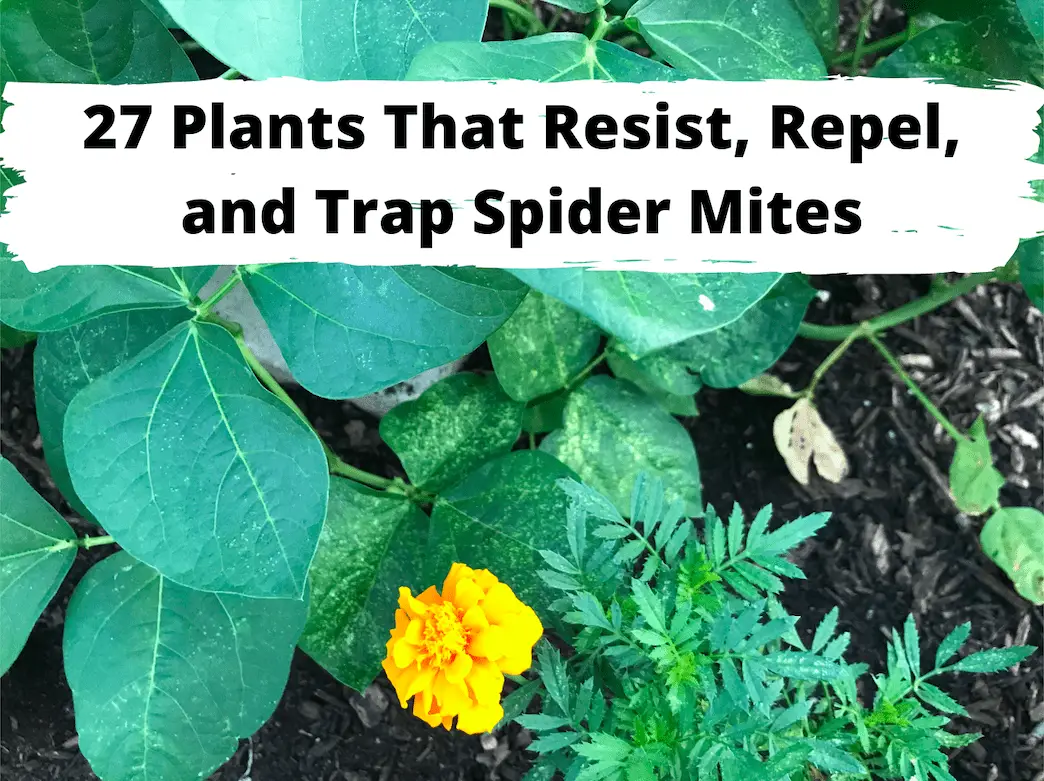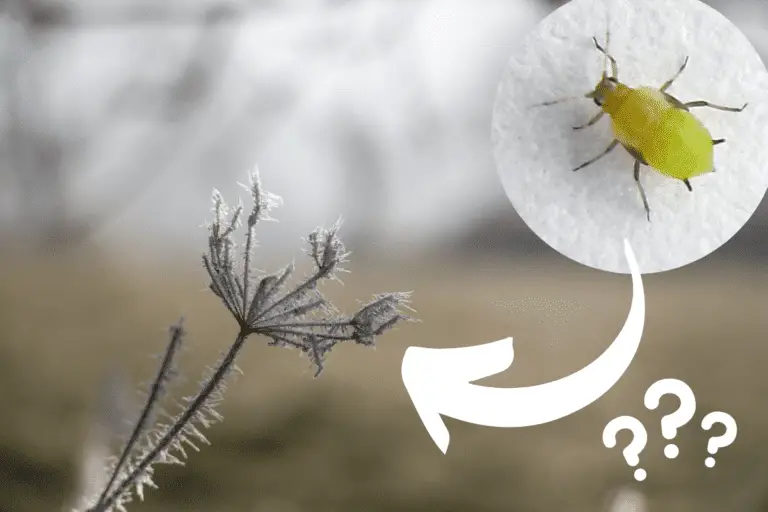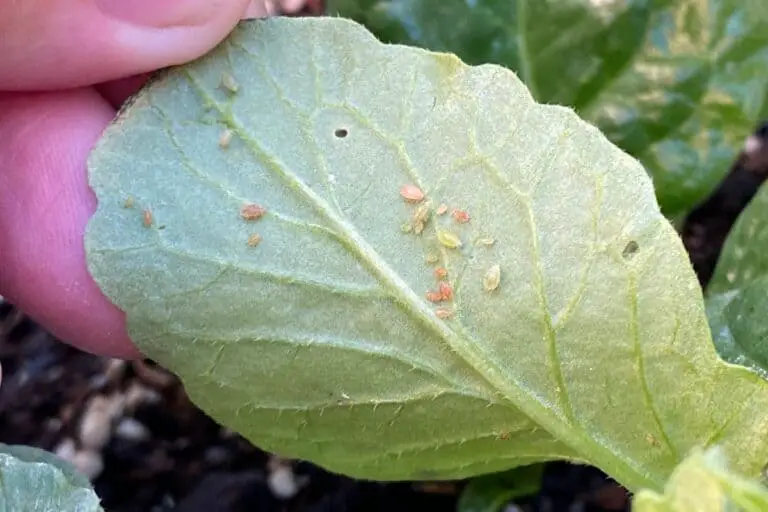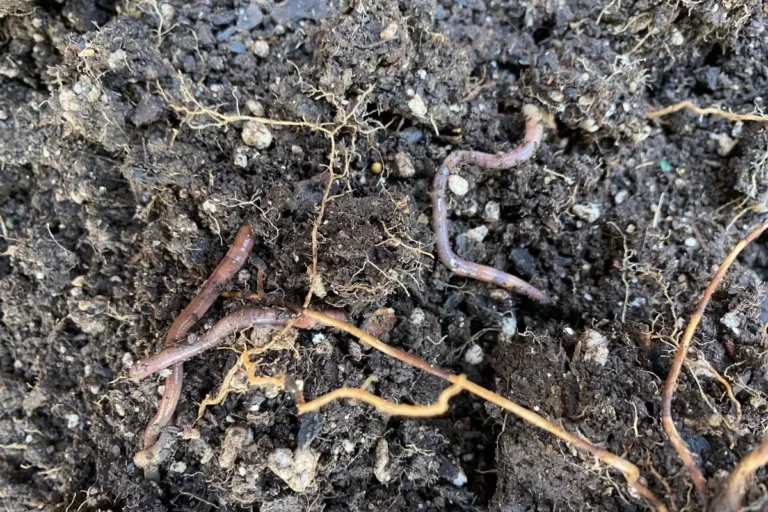27 Plants that Resist, Repel, and Trap Spider Mites
If you’ve gardened for any period of time, you’ve likely dealt with spider mites. These tiny little creatures appear unexpectedly and reproduce exponentially, and if you’re not careful, they’ll take over your garden in a few short weeks.
However, if you plan your garden properly, you can intersperse plants that spider mites attack with those that resist, repel, or even trap them. Doing so will slow down an infestation and lessen the overall extent of the damage whenever spider mites arrive on your property.
The most effective spider mite repellents are members of the Allium genus: chives, garlic, leek, onion, scallion, and shallot. Other resistant varieties include members of the Brassicaceae family (broccoli, kohlrabi, radish, rutabaga, and turnip) and herbs such as basil, Chinese parsley, and dill.
Disclosure: This post may contain affiliate links to some of my favorite products found on Amazon and other retail sites. I’ll earn a small commission from purchases made through those links, at no additional cost to you. Please read my product disclosure page to learn about the care I take when recommending products to my readers.
But in my experience, I’ve learned that there are numerous other garden varieties that stand up well against both minor and aggressive spider mite infestations and still others that function as helpful trap crops that keep spider mites preoccupied while you determine the best treatment methods to stop, kill, and get rid of these garden pests.
I’ve previously written about plants that spider mites like and hate–including shrubs, houseplants, and trees–but I wanted to provide a more thorough breakdown of the role that various garden veggies play when it comes to spider mite invaders.
Plants that repel spider mites are few in number–largely because spider mites reproduce quickly, spread easily, and are highly adaptive–and they are typically rather pungent. These plants are not 100% guaranteed to keep spider mites away since the latter are so widespread and prolific, but they have been shown to have positive effects when interspersed among other garden plants.
Many more plants–including root vegetables, herbs, and plants with hardy foliage–are fairly resistant to spider mites. They won’t deter such bugs, but they won’t experience too many problems during a spider mite infestation either.
Trap crops do the exact opposite as those that repel: they lure spider mites to their foliage. To be clear, they do not lure spider mites to your garden, but after spider mites have arrived, these plants roll out the proverbial welcome mat. The good news is that they’re doing exactly what they’re supposed to do. They’re luring spider mites away from your more desirable plants, making it easier to wipe out the infestation without damaging the plants you care about most.
What I’ve done below is this: I’ve developed a list of 27 plants that are some of the best performers overall when it comes to spider mites, and I’ve listed them below.
I’ve also got three products to recommend just in case spider mites show up. I use these in my soapy water sprays, and they work very well if you’re consistent with your applications:
- Castile Soap: You should always have a good bottle of castile soap lying around. I prefer Dr. Bronner’s Peppermint Castile Soap, but any Dr. Bronner’s product will work perfectly.
- Dish Soap: I don’t recommend using Dawn dish soap since it has chemicals I don’t want in my garden. Instead, just use a good organic dish soap, and you’ll be able to make a very effective soapy water spray.
- Insecticidal Soap: For bad spider mite infestations, I go with insecticidal soap since it’s designed to get rid of unwanted pests. Just be sure to follow the instructions on the label, and you’re good to go!
Now that you know what I use in my backyard, I’ve taken things one step further in this article. I’ve assigned each plant variety to one of three categories depending on how they protect against or react to spider mites:
You’ll find these groupings below the list. You can either read the article in its entirety or use the links above and below to read about your preferred plants.
| Basil | Bok Choy | Broccoli |
| Caraway | Carrot | Celery |
| Chard | Chinese Parsley | Chives |
| Chrysanthemums | Cowpeas | Dill |
| Eggplant | Garlic | Kale |
| Kohlrabi | Leeks | Okra |
| Onions | Parsnip | Peppers |
| Radish | Rhubarb | Rutabaga |
| Scallions | Shallots | Turnips |

Allium Plants
When it comes to plants that repels and resist spider mites, several vegetables in the Allium family can’t be beat. Not only do they fare well against spider mite, they also provide additional protection when you follow companion planting guidelines.
My favorite Allium plants include:
- Chives: in my experience, spider mites don’t have any interest whatsoever in chives. I had a beautiful plant growing right amidst a spider mite infestation, and they left it alone. No sign of them on the chives whatsoever. Much like other members of the Allium family, chives just aren’t appealing to spider mites.
- Garlic: Much like chives, spider mites seem to have no interest in garlic. But unlike chives, they seem to actually dislike being in proximity to garlic. I suggest planting garlic alongside cucumbers, melons, and tomatoes to provide added protection for these spider mite favorites.
- Leeks: Plant these next to tomatoes and lettuce to help ward off spider mites and other garden pests.
- Onions: I’ve read that onions can be somewhat susceptible to two-spotted spider mites (although not other mite varieties), so I’d be sure to plant them in tandem with garlic or Chinese parsley to get the full beneficial effect.
- Scallions: From what I’ve seen, these are pretty impervious to spider mites. I had a planter full of scallions right up against several infested tomato plants, but the scallions showed any signs of infestation. They didn’t repel spider mites (like garlic), but they weren’t damaged by them either.
- Shallots: I’m not sure if shallots have any repellent properties, but overall, they seem to be resistant to spider mites. In all my years of gardening, I’ve never heard of spider mites attacking these plants.
In general, Allium plants repel and resist spider mites in several ways. First, they’re typically more odoriferous than other garden plants, and their pungent smells make them relatively unattractive to spider mites. Second, they’re root vegetables, which means that even if spider mites show up and attack the foliage (as sometimes happens with onions), the root itself will remain protected against such attacks. Third, their foliage is also relatively tough compared to plant varieties that spider mites seem to prefer. If spider mites arrive in your garden, these plants can withstand the infestation until you begin a treatment plan to control and destroy the spider mite population.
There are no surefire ways to keep spider mites out of your garden each year, but if you plan things out and strategically place Allium plants around your garden, you’ll be giving your plants an extra line of defense against spider mites and other pesky garden bugs.
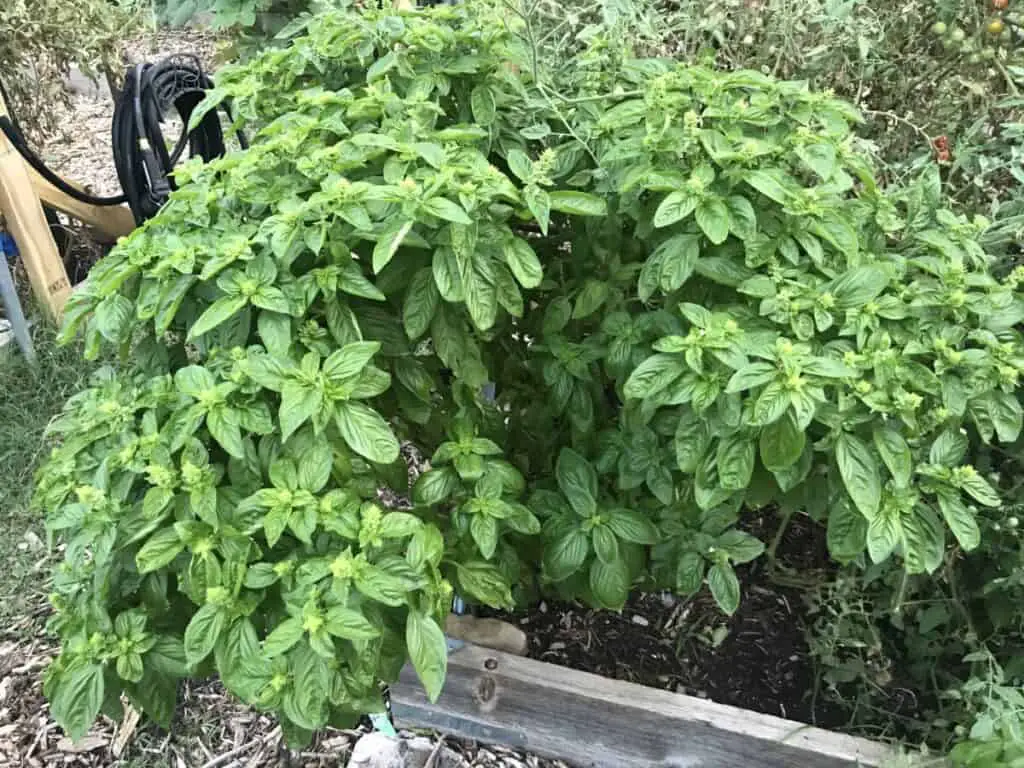
Basil
I’m sure it’ll surprise some people to see basil placed on a list of plants that repel, resist, and trap spider mites, but it’s worth noting what I saw this past summer.
Basil (Ocimum basilicum) is a beneficial herb to have in your garden for many reasons, but this past summer, I witnessed something interesting. I had three basil plants in different parts of my garden. One of them was planted directly next to several bell pepper plants and a large tomato plant; the other two were in the vicinity of numerous tomato plants.
Each of these tomato plants suffered varying degrees of spider mite infestations during the course of a long, hot Texas summer. I had to treat the basil for aphids at one point, but at no time throughout that entire summer did spider mites appear on any basil plants. They simply left them alone.
I’ve read some accounts online of basil suffering from spider mite infestations, but I’ve seen nothing but resilience from my basil plants despite moderate to severe spider mite infestations on nearby plants.
Bok Choy
I’ve heard of spider mites appearing on bok choy, but these appear to be rare instances. Bok choy (Brassica rapa chinensis) is often attacked by other bugs–such as aphids, cabbage loopers, and cutworms, to name a few–but they seem unappealing to spider mites overall.
Consider planting bok choy amidst other garden varieties in order to put some distance between plants that spider mites prefer. Watch out for aphids, though, since they’ll attack plants that spider mites won’t. Thankfully, I’ve found aphid infestations much easier to deal with than infestations caused by spider mites, so I’ve grown rather fond of bok choy over the past few years.
Broccoli
Broccoli (Brassica oleracea) suffers from its fair share of pests–among them aphids, cabbage worms, cutworms, flea beetles, and whiteflies–but they seem rather impervious to spider mites.
In fact, researchers at Western University in Ontario, Canada, sequenced the genome of the two-spotted spider mite back in 2012 and noticed that cellular substances known as indole glucosinolates, which are found in the brassicaceae family of plants, had noticeably negative effects on spider mites.
Does this matter to those of us hoping to grow healthy, spider-mite-free plants? No, of course not. But it serves to highlight why the best defense against spider mites is healthy plants. If your plants are healthy, their natural defenses will help you in the battle against spider mite invaders.
Caraway
I don’t have much use for caraway, but if you like cooking or baking with caraway seeds and are looking for an addition to your garden that’s rather impervious to spider mites, then caraway is the plant for you.
Caraway (Carum carvi) has wispy, feathery leaves, and much like dill, this sort of foliage does not provide the abundant chlorophyll that spider mites are looking for. But caraway plants produce plentiful seeds, which can be used in rye breads and other recipes, so having a few plants in your garden will provide you with all the seeds you need and none of the spider mites.
Carrot
What’s great about carrots is that the part I love most is buried underground and kept clear of spider mite infestations.
Of course, I realize that lots of people love eating carrot greens (and I do too!), but spider mites don’t seem all that interested in carrot greens. It could be that, like caraway and dill, the leaves don’t provide the kind of abundant chlorophyll that spider mites are looking for. Or it could be spider mites just don’t like the taste.
I’m not entirely sure, but either way, I’m happy that they mostly leave carrots alone.
Celery
In general, celery (Apium graveolens) isn’t prone to spider mite infestations, but when spider mites do occasionally appear on celery, the plant holds up well against them.
However, this is fairly rare because spider mites typically avoid celery for other, more preferred plants.
I’ve heard a few gardeners complain that—later in the summer during particularly hot, dry weather—they’ve sometimes found spider mites on their celery. But I don’t see this as much of a problem given celery’s overall resistance to spider mites.
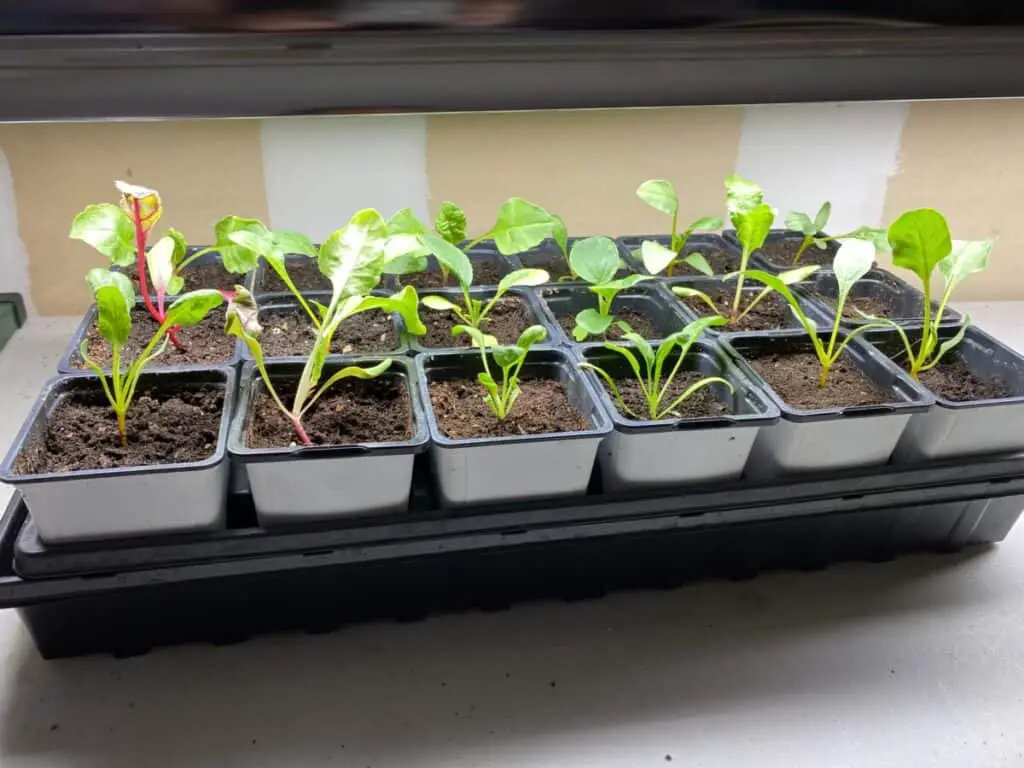
Chard
Chard (Beta vulgaris) had its fair share of garden pests—including aphids, flea beetles, and various worms—but they don’t seem to have any issues with spider mites.
In fact, In all my years of gardening, I’ve never heard of any spider mite infestations of chard plants. I have no idea why spider mites avoid chard, nor have I read any scientific explanations about this avoidance. Chard’s large broad leaves seem like they would make an enticing meal for spider mites, but no, those little pests show no interest in chard.
The good news is this: You don’t need to know the scientific reasons why spider mites avoid chard. They just do. So when planning in your garden, be sure to intersperse chard as a hedge against future spider mite arrivals.
Chinese Parsley
Chinese parsley is the common name for the herb that gives us both cilantro (its leaves) and coriander (its seeds).
Please don’t confuse Chinese parsley (Coriandrum sativum) with parsley (Petroselinum crispum). Although they’re both descended from the same family (Apiaceae), these plants are actually distant cousins since Chinese parsley isn’t actually parsley. Parsley is prone to spider mite problems. Chinese parsley is not. If you’re looking for an herb to help ward off spider mites in particular, don’t plant parsley. Plant its cousin.
By the way, if you let Chinese parsley go to seed instead of digging it up, those seeds–which are also known as the spice coriander–will fall off once warm weather hits and lay the groundwork for plenty of Chinese parsley the following season.
Chrysanthemums
When it comes to spider mites, chrysanthemums (Chrysanthemum indicum) are a fascinating plant because they have both repellent and trap-like qualities. On the one hand, chrysanthemum foliage, somewhat similar to marigolds, functions like a trap crop. On the other hand, chrysanthemum flowers produce chemical compounds that are collectively known as pyrethrins, and these chemicals repel all kinds of insects when used in foliar sprays.
Products such as Southern Ag’s Natural Pyrethrin Concentrate, Bonide’s Pyrethrin Garden Insect Spray, PyGanic’s Pyrethrin Concentrate are all highly rated and, when properly diluted, will make a great addition to your homemade insecticidal arsenal. If you’re not interested in a concentrated product, try Bonide’s Tomato and Vegetable Ready to Use Spray since pyrethrin is one of its primary ingredients.
Pyrethrin usually comes in concentrated form, and it’s pretty powerful stuff. However, it only remains effective until it dries, which means you’ll do best if you follow an application schedule (like the one I’ve written about in this article on neem oil sprays). For best results, spray in the evenings, right before the sun sets. That way, you’ll harm fewer pollinators, and you won’t burn your plants when things warm up the next day.

Cowpeas / Black-Eyed Peas
Growing up, I remember going to the grocery store with my mother and being asked to put bags of black-eyed peas in the shopping cart (my mother never called them “cowpeas,” by the way). So this past season, when I grew my own for the first time, I was reminded of childhood.
These plants are incredibly hardy. They love hot weather and full sun and will grow well even when temperatures reach 95+ degrees. They’re also highly resistant to bugs of all kinds.
When my plants were about 8 inches tall, I noticed the beginnings of a spider mite infestation on several plants (roughly 4 of the 20 or so that I had planted). I grew worried about this because I had no experience with spider mites and black eyed peas and didn’t know what would happen, but looking back, I didn’t need to worry.
The spider mites stuck around for a week or so, but the plants didn’t seem to care. They kept growing up my trellis at a quick pace. When leaf-footed bugs showed up twice later in the season, they didn’t care either. They just kept growing. The only thing that really put a dent in my black-eyed pea harvests was a pesky rat that found its way onto my property and managed to climb up my trellis to feast on the peas each week.
But spider mites? No, they weren’t an issue at all. If you’re looking for a spider mite resistant summer crop, or even just a cover crop for the hottest month or two of the year, consider black-eyed peas. They’re the workhorse of the summer garden.
Dill
Dill (Anethum graveolens) is one of my favorite herbs, although I rarely use it when cooking. Instead, I like it for two primary reasons. First, I use loads of dill when pickling vegetables–cucumbers, bell peppers, hot peppers, okra, green beans, carrots, radishes, etc. There’s something very rewarding about pulling out a jar of pickled veggies during the cold winter months that you prepared earlier that summer, especially when I didn’t pay $4 to buy a few sprigs of dill from the grocery store. Second, I appreciate that dill does double duty in my garden by warding off pests like spider mites.
The aromas and oils that impart so much flavor to pickled vegetables also make dill a contender for best spider mite repellent plant in my backyard garden. Not only does it have the odoriferous qualities that spider mites and other bugs dislike, but its thin, stringy foliage means that there’s not much there to interest spider mites since they’re typically drawn to plants with larger leaves that contain plenty of chlorophyll to feast on.
Much like Chinese parsley, dill will reseed itself each year if you continue caring for the bed after the plant stops producing and dries up. You can also harvest seeds easily, so I tend to do a bit of both: I’ll harvest 50% of the seeds for packaging and storing and leave the other 50% to self-seed naturally. If you follow this approach, you’ll have plenty of dill year after year!
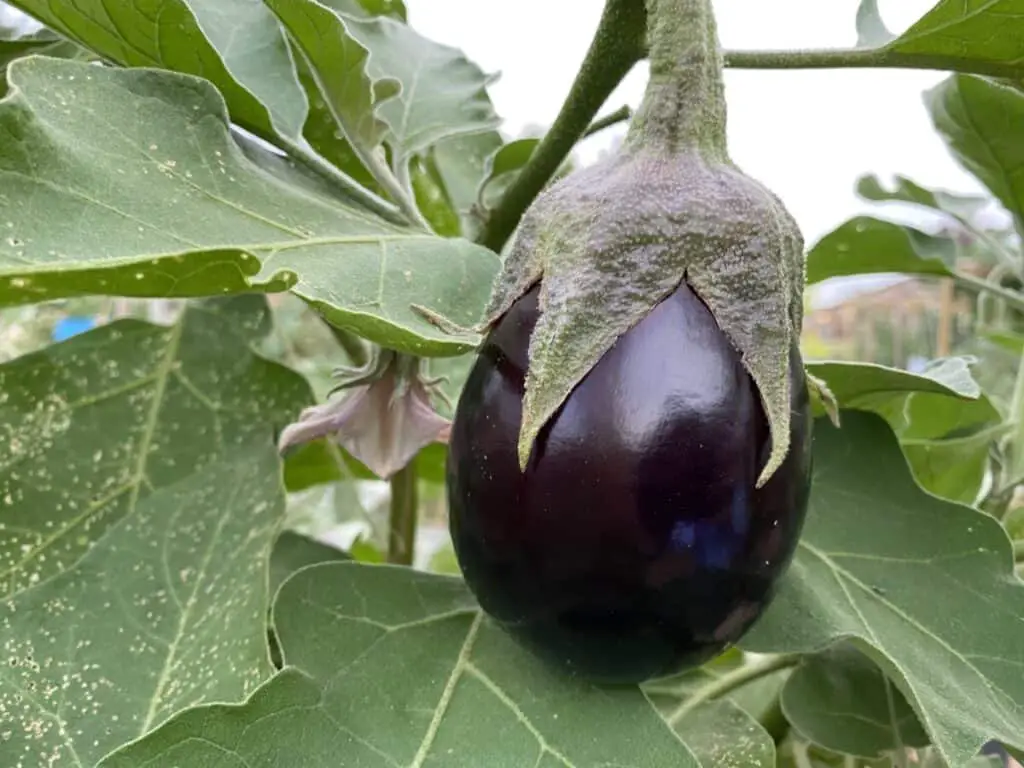
Eggplant
A distant cousin of tomatoes and peppers, eggplant (Solanum melongena) are, much like black-eyed peas, a garden workhorse. They can grow into enormous, bush-like shapes–I’ve seen them grow as big as 4 feet wide and 6 feet tall–and their hardy foliage stands up against a number of garden pests.
Spider mites love feasting on the large, wide leaves of eggplant. According to researchers at the University of California, eggplants are particularly prone to both the two-spotted mite and what some people have historically referred to as “carmine mites” (which are actually just red versions of the two-spotted mite).
You’ll typically find these pests on the undersides of the leaves. The first signs you’ll see are a discoloration–a stippling effect that, if left untreated, will eventually cause the leaf to change colors from light green to a pale yellow white as the spider mites drain it of its chlorophyll.
The good news is that, unlike tomato plants, eggplants hold up well against such attacks and give you time to treat the plant. As long as the infestation is kept in check–and assuming you have healthy soil–your eggplant will continue producing despite those pesky spider mites. I recently saw an eggplant that didn’t seem to care about a dual infestation on its leaves–both spider mites and flea beetles. Its leaves were discolored by the mites and had hundreds of tiny holes punched out of them by the flea beetles, but the plant kept going strong, producing dozens of eggplants along the way.
Just watch out for too much foliage damage. If your eggplants start shedding too many leaves, they’ll suffer as the season goes on, which will affect your overall harvest.
Kale
Aphids, caterpillars, harlequin bugs, white fliers–if you like growing kale, you’ve probably dealt with your share of these pesky bugs.
But you know what you haven’t had to deal with on your kale? Spider mites. I have no idea why spider mites avoid kale. I’ve never seen any scientific papers that offer any reasonable explanations. All I know is that, when it comes to kale, I’m not concerned about spider mites.
As far as I know, kale doesn’t have any repellent qualities, so spider mites are liable to appear on plants that are planted nearby, but if you plan well, you can plant kale in between plants that spider mites prefer so as to put some space between those plants if or when spider mites arrive on your property.
Just to be clear, a few feet between plants won’t stop spider mites. As I’ve noted in an article on where spider mites come from, they are quite adept at traveling between plants, garden beds, and properties. But putting space between plants that tend to attract spider mites might give you a headstart when it comes to identifying an early infestation and stopping the spider mites before they spread to other plants.
Kohlrabi
I’m relatively new to kohlrabi, having only grown it in the past year or so. But overall, I’m impressed by how well they grow in my area of North Texas, and I’m fairly experienced when it comes to handling cabbage worms and harlequin bugs, two of kohlrabi’s primary pests.
Many people suggest picking such bugs by hand, but I’ve found that a powerful hand vac is a much more efficient tool, especially for harlequin bugs. Instead of attacking them one by one, I use the hand vac to suck up several at a time–or even dozens, if I’ve got a bad infestation–then smash them all at once. You might find it kind of gross the first time you do it, but after you get over that initial queasiness, you’ll be a hand-vac-toting, bug-killing machine.
And what about spider mites? Well, much like kale, they avoid kohlrabi, so plant away!
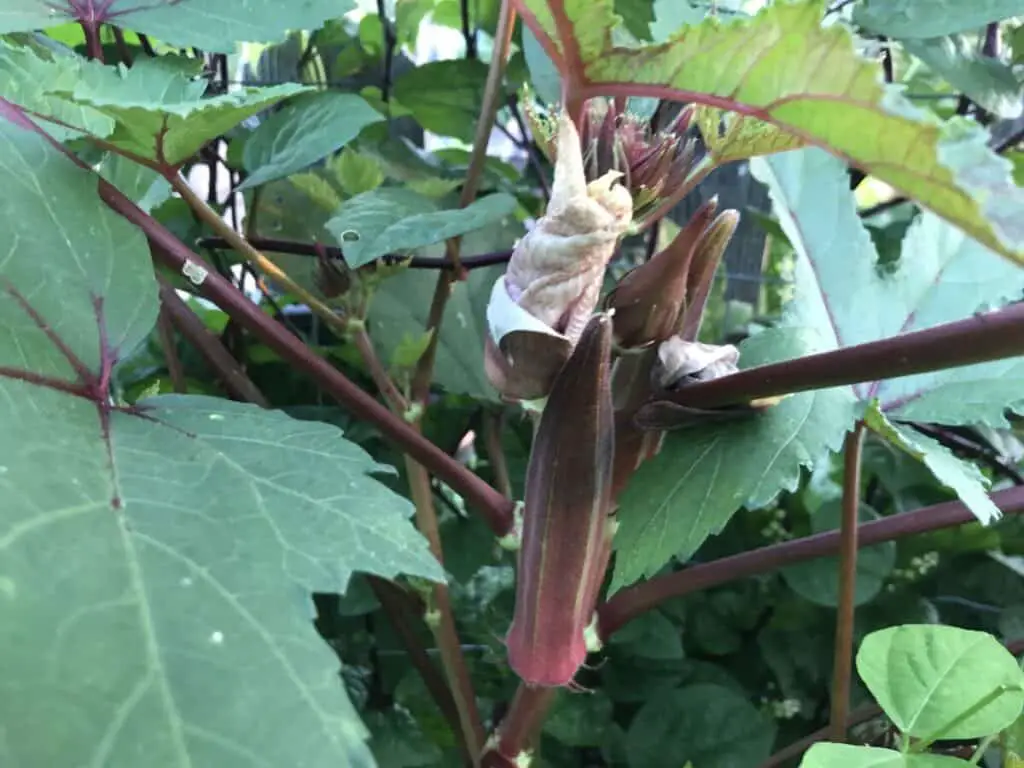
Okra
Have you got spider mites in your garden? Okra doesn’t care. Flea beetles? Okra doesn’t care. Leaf-footed bugs? Okra doesn’t care. Aphids? Okra only slightly cares. In my experience, when it comes to most garden pests, okra just doesn’t care.
In all seriousness, though, okra (Abelmoschus esculentus) is as hardy a plant as you can find in the garden. With stalks that can grow 10+ feet tall and that have diameters of 1-3 inches, these plants resist most garden pests and thrive in the kinds of hot conditions that cause other plants to suffer or go dormant. On the one hand, those are the exact conditions that spider mites love. On the other hand, okra foliage is so hardy that spider mites don’t seem to do much of anything to it.
If you’re looking for high-producing summer plants that’ll resist those pesky spider mites, you’ll want to grow okra in your garden. As a side benefit, the okra stalk provides a perfect natural trellis for other plants such as beans, malabar spinach, peas, sweet potatoes, and other climbing plants. I grew malabar spinach alongside okra this year, and they perfectly complemented each other. The okra held up just fine as the malabar spinach wrapped its vines around it, and the malabar spinach spread out by climbing up and around the okra stalk.
Parsnip
Like carrots, parsnip (Pastinaca sativa) doesn’t seem to have any problems with spider mites, neither the root itself nor the greens.
Personally, parsnips aren’t really my thing, so I don’t allocate space in my garden to them, but if you’re into parsnips and looking to incorporate more spider mite resistant plants into your garden, this is a great choice to plant alongside lettuce, peas, peppers, or tomatoes.
Peppers
I’ve previously written about my experiences with spider mites and peppers, but I thought I’d elaborate here.
In general, I’ve found that peppers are not as enticing as other plant varieties–such as cucumbers, eggplant, or tomatoes–so when I include them in a list of “resistant” plants, I do so assuming that you’ll be practicing companion planting.
If you’re growing peppers in a greenhouse, or if your garden doesn’t have much in the way of diversification, then you shouldn’t be surprised if spider mites appear on your peppers. If they’ve got to choose between peppers and nothing, spider mites will choose peppers every time.
But what I’ve seen is that, when planted alongside other more preferred plants, peppers stand up very well to spider mite infestations in the garden. Last season, I had a golden cayenne pepper plant growing in between several tomato plants that showed early signs of a spider mite infestation. In a different bed, I had two bell pepper plants and a sweet pepper plant growing next to a massive cherry tomato plant.
I dealt with the first spider mite infestation quickly, and within a week or so, things were back to normal. In that time, the golden cayenne showed no signs whatsoever of spider mites even though they were trying to infest the plants around it. In the second instance, I didn’t pay close attention to the cherry tomato plant, and spider mites started taking over after a few weeks. I began a treatment plan, but it was already too late. The plant was too far gone after 4-5 weeks–not to mention suffering from early blight anyway–so I pulled it up.
What amazed me was the state of the three pepper plants growing right next to it. At no point in time did the spider mites migrate to the peppers, despite infesting a cherry tomato plant that was literally growing up against them. The spider mites simply left it alone and focused their attention on the tomato plant’s foliage.
Radish
The radish (Raphanus raphanistrum) is, like parsnips and rutabagas, a hardy root vegetable that’s a great producer and that, from what I’ve seen over the years, doesn’t have any issues with spider mites. They seem to ignore the greens, which is great since radish greens are great additions to any salad.
Most people, when thinking about radishes, only think about the scarlet, globe-shaped vegetable, but radishes come in an amazing assortment of colors–red, yellow, white, green, purple, pink, even black. If you’d like to try something new this year, check out the seed options at some of my favorite online retailers:
Rhubarb
Rhubarb (Rheum × hybridum) is cultivated for its edible stalks, which are most often cooked and used in pies, tarts, crumbles, and other fruit-filled desserts. The leaves of this perennial plant can’t be eaten, and its stalks need to be properly cooked or else they’ll taste rather sour.
Overall, I’m not a huge fan of rhubarb pies and other rhubarb-based desserts, so this plant is not really my thing. But if you’re into those kinds of sweets, and if you’ve got an interest in a perennial garden plant that’s of no interest to spider mites, rhubarb is the plant for you.
Rutabaga
Rutabagas (Brassica napus) are a versatile root vegetable. They can be mashed, sliced, peeled, fried, roasted, turned into noodles, and even added to salads and soups.This cool season plant has roots that are similar to turnips, except bigger and sweeter, and edible leaves that are smooth and somewhat similar to cabbage.
Like other root vegetables, rutabaga are susceptible to aphids, caterpillars, flea beetles, and root maggots, but they have no issues when it comes to spider mites.
Turnips
A distant cousin of bok choy and Napa cabbage, the turnip (Brassica rapa) thrives in cool weather, which means it gets going once spider mites are starting to slow down for the season. Much like other root vegetables, the fleshy bulbs are immune to spider mite attacks while the greens, which are wonderful when cooked, aren’t susceptible to spider mites.
This doesn’t mean that turnips don’t have their fair share of bugs. Cabbage aphids, caterpillars, flea beetles, and whiteflies: these are all drawn to turnips. Thankfully, spider mites aren’t.
What Plants Repel Spider Mites?
Let’s be clear at the start: The best natural spider mite repellent is a garden with nutrient-rich, well-watered soil and healthy plants, which provide the best defense possible against these tiny bugs. But whether you’ve got such a garden or not, there are several plant varieties that have observably repellent qualities.
Spider mites are primarily repelled by Chinese parsley, chrysanthemums, dill, garlic, leeks, lemongrass, peppermint, and rosemary. These plants are touted by gardeners who practice companion planting and those who prefer to use organic, homemade sprays in lieu of chemical insecticides.
With the exception of chrysanthemums (which I’ve noted above), you’ll notice that these plants are primarily herbs and root vegetables and are all relatively pungent. I’ve not seen any scientific papers exploring why exactly these plants repel spider mites, but it stands to reason that their ability to repel such bugs has a lot to do with their odoriferous qualities.
Here’s my list of plants that seem to have spider mite repellent qualities:
- Anise
- Caraway
- Chamomile
- Chinese Parsley
- Chrysanthemum
- Cinnamon
- Dill
- Garlic
- Leek
- Lemongrass
- Marjoram
- Peppermint
- Rosemary
- Shasta Daisy
- Thyme
What Plants Resist Spider Mites?
Unlike plants that have distinctly repellent qualities, there are quite a few that hold up well against spider mite infestations. These plants can be damaged by spider mites, but they’ll either be overlooked for more desirable plant varieties, or they’ll keep growing strong despite spider mite attacks.
Basil, broccoli, chives, kale, peppers, scallions, and practically all root vegetables are resistant to spider mites. Cowpeas, eggplant, and okra are susceptible to spider mites, but they’re hardy and grow relatively quickly, so they’ll continue producing despite spider mite infestations.
Many spider mite resistant varieties grow best during cooler times of the year. Given spider mites’ preferences for dry, hot weather, this is probably one major reason why they’re not particularly prone, if at all, to spider mite infestations.
See my list below of plants that are, for one reason or another, resistant to spider mites:
- Basil
- Bok Choy
- Broccoli
- Carrot
- Celery
- Chard
- Chives
- Cowpeas / Black-Eyed Peas
- Eggplant
- Kale
- Kohlrabi
- Okra
- Onion
- Parsnip
- Pepper
- Radish
- Rhubarb
- Rutabaga
- Scallion
- Shallot
- Turnip

What Plants Trap Spider Mites?
Unlike plants that are designed to repel or resist spider mites, the plants below will attract them.
Just to be clear, these plants won’t attract spider mites to your garden in the first place. What I’ll do is attract spider mites after they’ve already arrived.
Chrysanthemums, marigolds, parsley, and vitex are sometimes thought of as “trap crops” for their ability to distract pests like spider mites from other, more valuable garden plants. By trapping spider mites, they give gardeners additional time to begin treating the infestation.
Trap crops work best when planted among varieties that are typically more susceptible to spider mite attacks. Four well-known ones are:
Chrysanthemum
Chrysanthemums are interesting in terms of their relationship to spider mites. In the one hand, their foliage serves to attract mites that have arrived in your garden. On the other hand, their flowers produce a chemical called pyrethrin, which is used in organic insecticidal sprays.
In other words, they’re a decent trap crop for your garden. Just don’t confuse them for one of the repellent plants above when you read an article talking about pyrethrin.
Marigold
My favorite trap crop by far, marigolds will not only look pretty in the garden, but they’ll also attract beneficial pollinators while delaying any spider mite invaders that arrive.
Spider mites can damage marigold plants, but the plants are very hardy. They’ll withstand spider mites while continuing to grow and bloom, giving you additional time to deal with the infestation. Because as long as the spider mites are on your marigold plants, they won’t be feasting on the garden plants you care most about.
Parsley
Unlike Chinese parsley, parsley (Petroselinum crispum) does not repel spider mites. It seems to be a plant that they’re attracted to But I’ve had great success with it over the years. In fact, I tend to grow more than I need, so when mites do arrive, I prefer to see them congregate on my parsley instead of my tomatoes.
Vitex
I have very little experience with Vitex, but from my research, it appears that it will function as a good trap crop. It’ll be a decoy that hopefully distracts spider mites while you work to ensure they don’t spread to your more preferred plants.
Do you know of any other plants that resist, repel, or trap spider mites? I’d love to hear about them! Please contact me at backyardgardengeek@gmail.com if you’ve got any additional suggestions.
Should I Be Worried About Spider Mites?
Let me just say this, if you have nutrient-rich, properly-watered soil and healthy plants, you should keep your eyes open for spider mites, but I don’t think you need to worry too much about them overall. That’s especially the case if you’ve planted the varieties I’ve listed above throughout your garden.
Spider mites love dry, hot weather and thrive among plants that are stressed or unhealthy. They are particularly difficult to manage in areas with fewer natural predators (such as greenhouses) or on commercial properties that practice monoculture farming and thus don’t benefit from plant varieties that resist, repel, or trap spider mites.
In general, I would give two pieces of advice to those who are worried about fending off spider mites this year:
First, read as much as you can about spider mites so that you can recognize the earliest signs of an infestation and know what to do thereafter. I’ve tried to write down everything I’ve learned about spider mites over the years to help other gardeners, so please check out the articles below for more information:
- Are Spider Mites Spiders? How to Identify These Garden Pests
- What Plants Do Spider Mites Like, and What Do They Hate?
- Can Plants Recover from Spider Mites? What You Need to Know
- Will Spider Mites Spread to Other Plants?
- Using Neem Oil to Kill Spider Mites: A Complete Guide
(And if you’ve got questions about spider mites that I haven’t answered in these articles, please let me know so that I can do more research, conduct more experiments, and provide more helpful advice!)
Second, If you notice that spider mites have arrived in your garden, act immediately and aggressively. Use a planner, a notebook, or a calendar app to develop a day-by-day treatment plan depending on the level of infestation. And make sure that you have the right ingredients on hand to make powerful organic insecticidal sprays.
Please be warned: Don’t wait until after spider mites have arrived to buy these ingredients. Buy them now so that you’ll have them when you need them. You can read more about the ingredients I use in my article on using neem oil effectively, but for those who are interested, these are the products I have on hand whenever I need to quickly mix up a powerful spider mite-killing spray:
- Applicator: I’ve used these 1- or 2-gallon spray bottles sold by Chapin or Vivosun, but any sprayer will work just fine.
- Neem Oil: My preferred brands are Verdana Neem Oil and Neem Bliss Neem Oil, but any decent neem oil concentrate will work just fine.
- Soap: You need an emulsifier to ensure that your neem oil and water mix well. I’ve used Dr. Bonner’s, Mrs. Meyer’s, or Safer Brand over the years. But really, any mild soap will do. Dawn is fine for some people, but I’m willing to pay a tiny bit more to get something without the unnecessary chemicals.
Long story short, if you’ve seen spider mites in your garden, now is not the time to be lackadaisical. Spider mites reproduce exponentially, and they can destroy your plants in a few short weeks. Be sure to begin treating your plants as soon as possible after you notice the first signs of infestation.
How Do I Know If I Have Spider Mites?
Spider mites are nearly microscopic, so unless you know exactly what to look for, you’re not going to see them when they first arrive on your property. The key to stopping spider mites is to recognize the signs of infestation as soon as possible.
Foliage stippling provides the earliest warning signs of a spider mite infestation. As spider mites attack plants’ cellular structures, sucking them dry of chlorophyll, they leave behind tiny clusters of white dots. As the infestation worsens, the stippling effect will give way to white and brown splotches of dead, decaying plant material.
When it comes to the stippling effect, this is what I refer to as a Stage 1 infestation. As time goes on, and as the infestation moves beyond Stage 1, you’ll notice more concerning signs. The stippling affect will spread until the dots no longer look like dots but patches of white. Eventually those blotches will cover entire leaves and branches, and the foliage will soon begin to die off.
As the infestation continues, the spider mites will begin spinning wispy webs around leaves and branches, which is the primary way they travel from plant to plant since the wind will carry these webs across your garden and even onto neighboring properties.
Do you think you have spider mites in your garden? If so, follow the directions in this article on neem oil, and hopefully, you’ll have caught the infestation early enough to take care of your spider mite problem within a few short weeks.
What Smells Do Spider Mites Hate?
I used my local university’s library to scour various scientific journals, but I haven’t seen any research explicitly focused in smells that spider mites hate. But given the kinds of plants that repel spider mites—and my experiences fighting them over the years—I think I can make some fairly accurate observations.
Spider mites seem to dislike strong, powerful smells, which might be one reason why they stay away from intensely odiferous plants. Acrid-smelling veggies, especially those with sulfurous odors (like members of the Allium species), seem particularly repellant to spider mites.
I doubt this is the only reason why spider mites stay away from certain plants, but in the absence of scientific evidence, I rely on personal experience. And my personal experience with spider mites is that they tend to stay away from garden plants that have particularly pungent smells.
